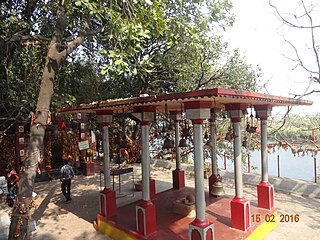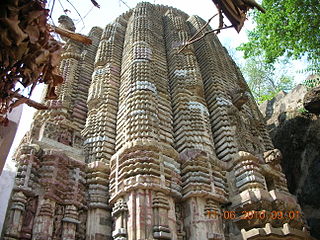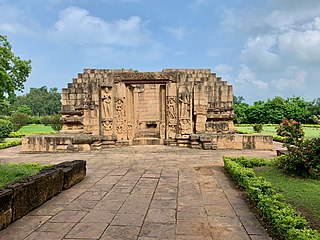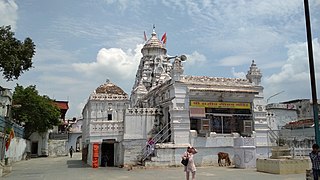
Sambalpur District is a district in the western part of state of Odisha, India. The historic city of Sambalpur is the district headquarters.

Rajnandgaon is a district of the state of Chhattisgarh in central India. The administrative headquarters the district is Rajnandgaon town.

Dakshina Kosala is a historical region of central India. It was located in what is now Madhya Pradesh and Chhattisgarh along with parts of Western Odisha. At its greatest extent, it may have also included a part of the Vidarbha region in present-day Maharashtra.

Bargarh District is an administrative district of Odisha state in eastern India. The city of Bargarh is its district headquarters. The district was carved out of the erstwhile district of Sambalpur on 1 April 1993.
Kharod is a town and a nagar panchayat in Janjgir-Champa district in the Indian state of Chhattisgarh. Kharod is historically very important place for Chhattisgarh.

Malhar is a small town situated in Bilaspur district of Chhattisgarh, India. A historically important site that once was a major city and served as a capital in the 1st millennium, it has been referred to as Mallar, Mallari and Sarabhapur in inscriptions and Indian literature. In contemporary times, it is more village like with mounds and ruins of an ancient fort, two restored Shiva temples and a museum with the ruins of major group of Hindu, Jain and Buddhist temples. It has archaeological significance. It is about 30 kilometers southeast from Bilaspur in a rural terrain, connected with a feeder road from India's National Highway 49.
Western Odisha is the western part of the state of Odisha in India, extending from the Kalahandi district in the south to the Sundargarh district in the north.

Bhumija is a variety of north Indian temple architecture marked by how the rotating square-circle principle is applied to construct the shikhara on top of the sanctum. Invented about the 10th-century in the Malwa region of central India during the Paramara dynasty rule, it is found in Hindu and Jain temples. Most early and elegant examples are found in and around the Malwa region, but this design is also found in Gujarat, Rajasthan, Deccan and some major Hindu temple complexes of southern and eastern India.

Bhoramdeo Temple is a Hindu temples dedicated to the god Shiva in Bhoramdeo, in the Indian state of Chhattisgarh. It comprises a group of four temples of which the earliest is a brick-temple. The main temple is the Bhoramdeo temple built in stone. The architectural features with erotic sculptures has given a distinct style akin to the Khajuraho temple and the Konark Sun Temple in Odisha, and hence the Bhoramdeo complex is known by the sobriquet the "Khajuraho of Chhattisgarh".
Suresvara Mahadeva temple, also known as Byamokesvara temple, is located in the Tala bazaar market complex, Old Town of Bhubaneswar, the capital of the state of Orissa, India. The temple is located in front of the Lingaraj Temple across the road in the left side of the eastern gateway at a distance of 10.00 m. The temple faces towards the west. It is a living temple and the enshrined deity is a Siva lingam with a circular yonipitha at the centre of the sanctum. At present the sanctum is 1.50 m below the present road level. It is a recently recovered temple that had been buried. It was built in 10th century AD. The temple is maintained by the local shopkeepers.
Lakhesvara Siva temple Location: Lat 20° 14’ 33"N, Long 85° 50’ 17" E, Elev 60 ft. Approach- Lakhesvara Siva temple is located in the right side of the Ganges–Yamuna road, behind the Lingaraja market complex, Old town, Bhubaneswar, Orissa, India. It is situated at a distance of 70 metres north east of Lingaraj temple and at a distance of 10 metres south of Gangesvara and Yamunesvara Siva temple across the road. The temple is facing towards the east. The enshrining deity is a Siva lingam within a circular yoni-pitha, which is 0.77 metres below the chandrasila.
Sukutesvara Temple located in the old town of bhubaneswar, Odisha,India,serves as purpose for community gathering. The preceding deity in this temple is a Siva- lingam situated at the centre. The temple observes various religious sacraments like Mahasivaratri, Chandipatha and Rudrabhisekha.
Dhanga, also known as Dhaṇgadeva in inscriptions, was a king of the Chandela dynasty of India. He ruled in the Jejakabhukti region. Dhanga established the sovereignty of the Chandelas, who had served as vassals to the Pratiharas until his reign. He is also notable for having commissioned magnificent temples at Khajuraho, including the Vishvanatha temple.

The Kalachuris of Ratnapura, also known as the Haihayas of Ratanpur, were a dynasty that ruled in Central India during the 12th and 13th centuries. They ruled parts of present-day Chhattisgarh from their capital at Ratnapura. They were an offshoot of the Kalachuris of Tripuri, and ruled as vassals of the parent dynasty for many years.
Madhyadesha or the "middle country" was one of the five sub-divisions of ancient India that extended from the upper reaches of the Ganga and the Yamuna to the confluence of the two rivers at Prayaga. The territory of middle region constitutes a cogent entity — geographically as well as culturally. Inside northern India this region has been instrumental in guiding the main currents of history and the spread of civilization from a very early age.

Sirpur Group of Monuments are an archaeological and tourism site containing Hindu, Jain and Buddhist monuments from the 5th to 12th centuries in Mahasamund district of the state of Chhattisgarh, India. Located near an eponymous village, it is 78 kilometres (48 mi) east of Raipur, the capital of the state. The site is spread near the banks of the river Mahanadi.

Brahma Temple is a ninth or early tenth century temple and is located at Chhatarpur in Madhya Pradesh, India. Although titled after the Hindu god Brahma, the temple is dedicated to Shiva. This temple, along with many others built during the Chandela dynasty, form the UNESCO World Heritage Site of Khajuraho Group of Monuments.

The Chindaka Nagas were a dynasty that ruled over parts of modern-day Odisha and Chhattisgarh. Their kingdom was known as Chakrakota mandala and included the present-day districts of Bastar, Koraput and Kalahandi. They were constantly at war with their neighbours- the Somavamshi dynasty, the Kalachuris of Ratnapura, the Mana dynasty and the Western Chalukya Empire.

Rajiv Lochan Temple is a temple located in Rajim, in the Indian state of Chattisgarh. It is dated to the 8th century CE.

Siddheshwar Temple is a temple located in Palari, in the Indian state of Chhattisgarh.















